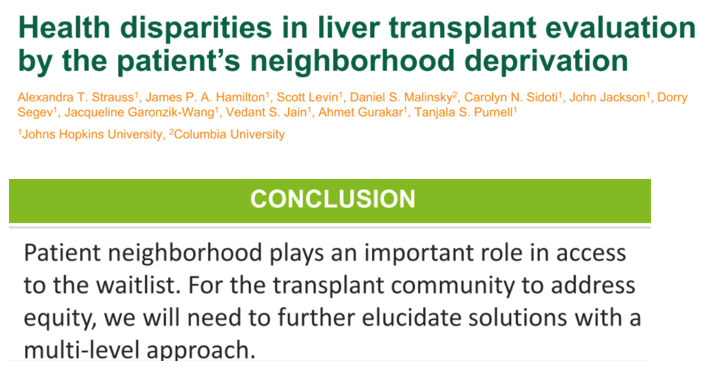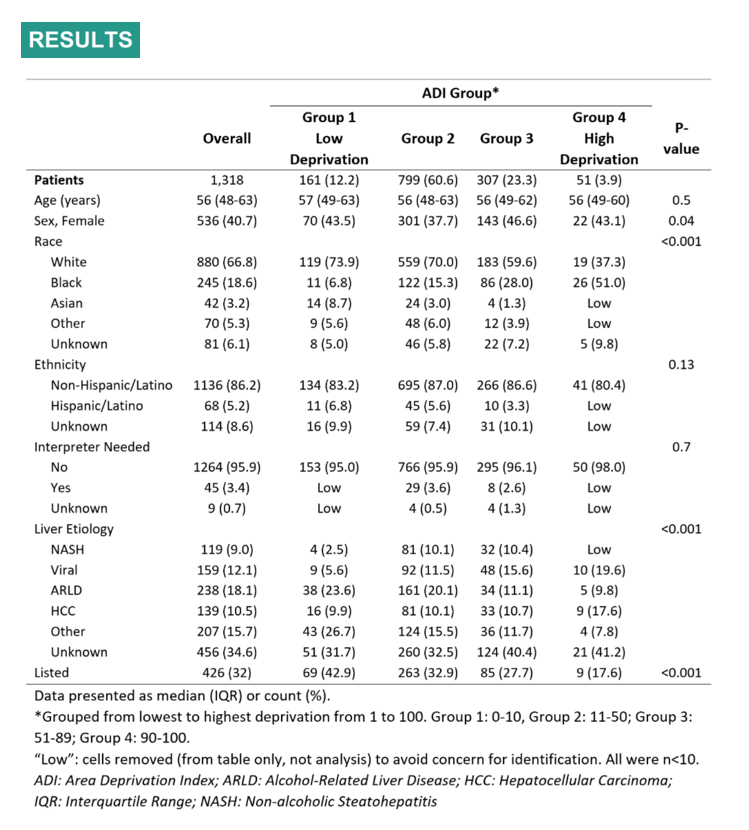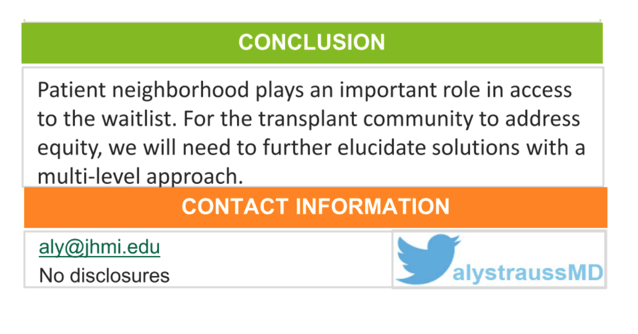 |
 |
 |
| |
HEALTH DISPARITIES IN LIVER TRANSPLANT EVALUATION BY THE PATIENT'S NEIGHBORHOOD DEPRIVATION - "The most deprived group had a significantly higher proportion of patients that were black"
|
| |
| |
AASLD 2021 Nov 12-15
Alexandra T Strauss1, James P. Hamilton1, Scott Levin2, Daniel S. Malinsky3, Carolyn N. Sidoti4, John Jackson5, Dorry L. Segev4, Vedant S. Jain4, Ahmet Gurakar1 and Tanjala S. Purnell5, (1)Division of Gastroenterology and Hepatology, Johns Hopkins University School of Medicine, (2)Department of Emergency Medicine, Johns Hopkins University School of Medicine, (3)Department of Biostatistics, Columbia University School of Public Health, (4)Department of Surgery, Johns Hopkins University School of Medicine, (5)Department of Epidemiology, Johns Hopkins University School of Public Health
Background: Although health disparities are revealed throughout most aspects of liver transplantation, the role and distribution of neighborhood-level factors on the evaluation process are not well understood. Building on literature demonstrating an impact of structural racism from neighborhood-related measures on health outcomes in other fields, our aim was to evaluate the relationship between the patient's neighborhood and liver transplant evaluation.
Methods: In this single center retrospective cohort study, we linked electronic health record data with the Area Deprivation Index (ADI). The ADI is a validated construct utilizing 17 neighborhood-based measures (e.g., employment, income, education) from the American Community survey to rank census block groups across the country by percentile (1: least disadvantaged, 100: most disadvantaged). Our study included adults ≥18 years-old who were referred to our transplant center for liver transplant evaluation from 8/1/2016-12/31/2019. Participants without an ADI available were excluded. We stratified patients by ADI into 4 percentile-based groups and included patient characteristics. The primary outcome was listing decision. We compared cohorts using χ2 test or Fisher's exact test for categorical variables and Kruskal-Wallis test for continuous variables.
Results: The 1,318 patients in our cohort were stratified by ADI, and 161 patients (12.2%) were in Group 1 (0-10 percentile: least disadvantaged), 799 patients (60.6%) in Group 2 (11-50 percentile), 307 patients (23.3%) in Group 3 (51-89 percentile), and 51 patients (3.9%) in Group 4 (>89 percentile, most disadvantaged) (Table). The median age of patients was 56 (IQR 48-63), and 536 (40.7%) were females; both age and sex were similar across ADI groups. The most deprived ADI group had a significantly higher proportion of patients that were black (Group 4: 51% vs Group 1: 6.8%; p<.001). Compared to Group 1, Group 4 had a higher proportion of liver disease due to hepatocellular carcinoma (17.6% vs 9.9%) and viral etiology (19.6% vs 5.6%) (p<.001). Of all patients in our cohort, 32% (426) were listed. The most disadvantaged ADI group had the lowest proportion of patients listed with a dose-response observed across groups (Group 1: 42.9%, Group 2: 32.9%, Group 3: 27.7%, Group 4: 17.5%, p<.001).
Conclusion: These findings demonstrate that the patient's neighborhood plays an important role in access to the waitlist. For the transplant community to address equity, we will need to further elucidate solutions that are focused on barriers at the structural, health system, and transplant center level.




|
| |
|
 |
 |
|
|